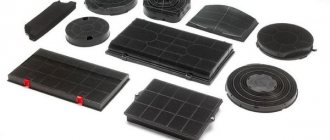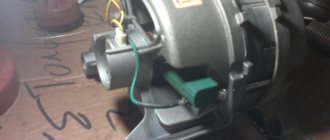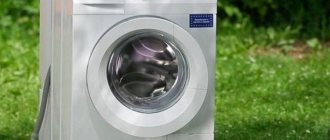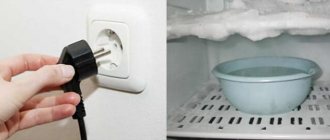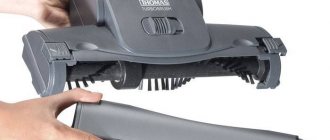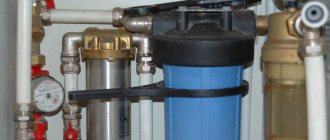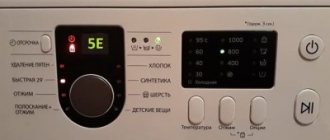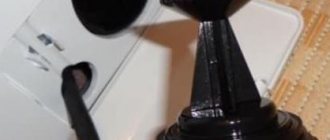Before purchasing a recirculating hood, you must understand that in order to operate it properly, you will have to spend money on replacement consumables from time to time. More precisely, there is only one consumable - a carbon filter for the hood, which eliminates unpleasant odors in the kitchen and protects the engine from contamination.
Let's figure out what work the filter does, how to choose the right replacement element and install it. The information provided will be useful to those who are just thinking about buying a recirculation type hood and to those who are already using such a unit.
Types of kitchen hoods
The hood is an important element in ensuring normal ventilation in the kitchen. The speed at which odors are removed from the room depends on its effectiveness.
Carbon filters are a mandatory component not for all types of hoods, but only for recirculating ones, so let’s first remember what types of air purification devices there are in the kitchen.
According to the method of air flow, all hoods can be divided into three categories:
- flow-through;
- circulation (recirculation);
- combined.
Flow hoods are connected to the ventilation duct using a rigid or flexible air duct.
The air containing kitchen fumes enters the hood and then into the ventilation. Various types of flow-through devices are also equipped with filters, but their function is slightly different - to protect the motor from an aggressive environment.
Recirculation devices do not require air ducts.
A hood without an air duct is installed above the stove so that it does not interfere with cooking. The width of the panel must be no less than the width of the hob
The air flow in the circulation model comes from the stove into the housing, passes through 2 cleaning stages (2 types of filters - anti-grease and carbon), and then returns to the kitchen space.
Comparative diagram of air movement in recirculation and flow (exhaust) modes. To ensure an exhaust effect, access to fresh air is desirable during equipment operation.
Combined models have an additional recirculation function. That is, you can insert carbon filters and start the recirculation mode, or you can connect an air duct and use the flow function.
How to clean greasy metal mesh
It is recommended to wash grease and soot from mesh filters made of stainless steel or aluminum at least once a month. The ideal option is weekly washing, then the grille does not have time to become overgrown with plaque and is easy to clean.
The easiest way to remove deposits, recommended by manufacturers, is to remove and place the catch screen in the dishwasher. This option is not suitable in case of heavy soiling, and not every home has a dishwasher.
To clean the grates, use any alkaline-based household products that dissolve fats:
- regular baking soda;
- laundry soap;
- gel intended for washing dishes and plumbing;
- cleaning fluids for ovens, gas and electric stoves (some come in a spray bottle).
Advice. In particularly advanced cases, when the hood has not been washed for years, the listed chemicals will not help. Buy a powder or gel for breaking through clogs in sewer pipes like “Mole” or a caustic liquid that clears soot from pots (for example, “Milam”). Be sure to wear rubber gloves while working!
If the contamination is minor, there is no point in purchasing household chemicals - just wash the mesh with soda. How to clean a metal filter using this method:
- Remove the dirty hood grate and place it in a wide iron container (bowl).
- Prepare a cleaning solution consisting of 3-5 liters of water and 1-2 packs of soda. Pour the liquid into a bowl with a wire rack.
- Heat the container on the stove and boil over low heat for 10-15 minutes. If the dirt does not come off, continue boiling. After rinsing and drying the filter, replace it.
Important point. Before installing the cleaned mesh, carefully inspect the internal cavity of the hood and the fan housing - you will probably find drops of grease on the surfaces. We mentioned the reason above - mesh elements do not retain 100% of vapors. It is better to remove plaque immediately - once it has accumulated it is much more difficult to clean.
Gels and special cleaning liquids are used according to the instructions on the packaging. Typically, the product is applied to the filter grid and left for the specified time. It doesn’t hurt to additionally rub the mesh cells with a hard plastic brush or brush, then wash with running water and dry. The technology for using various means is shown in the next video:
Design and principle of operation of a carbon filter
The appearance of the filter may vary, as it is made of either plastic or synthetic fabric. In the first case, it is a round or rectangular plastic cassette filled with activated carbon in the form of powder or granules; in the second, it is a dense piece of material impregnated with the same activated carbon.
Sometimes these two types are combined to create more effective protection against hot vapors and impurities that pass through them.
Charcoal cassettes are often round in shape and sold in sets of two. The plastic from which the cassette body is made is safe and does not emit harmful substances when heated
Carbon filters should not be confused with anti-grease filters, which are a metal mesh or grate and are the first stage of protection. Particles of fat and substances settle on the anti-fat barrier - this is a kind of coarse filter, but it does not retain odors.
And the charcoal filter passes through air that has already been cleared of grease, and this is what eliminates unpleasant and pungent cooking aromas.
The carbon filter is hidden inside the housing. Most often it is attached directly to the motor. And everyone has seen the anti-grease grille - it’s a steel or aluminum mesh, which is in plain sight, at the bottom of the hood
When choosing replacement units for your hood, you should follow the manufacturer’s recommendations. The fact is that in order to increase the demand for products, most of the filter cassettes and cartridges are universal in nature, that is, they are suitable not for one specific model, but for several. The list can contain up to 20 items.
On the packaging, the manufacturer indicates for which models of kitchen hoods the filter element is suitable (+)
You should ask the seller about the availability of consumables before purchasing a hood, otherwise you will soon encounter an unpleasant situation. After six months or 3-4 months (the service life is indicated in the instructions), you will want to purchase replacement cartridges, but you will not be able to find them on the open market.
This is especially true for the latest models that have just appeared on the market. If the problem has already occurred, try looking for a replacement in online stores.
Operating principle of coal protection:
- First, the air passes through a dense layer of viscose soaked in a charcoal solution. Some of the impurities and fat remain in the fabric structure.
- The partially purified air is then directed into the cassette where the granules are located. Activated carbon has remarkable properties - it not only traps residual impurities, but also absorbs specific odors.
Several cleaning cycles completely free the air flow of dirt and kitchen aroma. When the properties of the filler, “clogged” with grease and dirt, decrease, a new filter must be installed. In this regard, devices with sensors that indicate the need for replacement are very convenient.
Grease filter for hood
- Capable of removing dust microparticles and small fat droplets from the air.
- Installed “at the entrance” to the exhaust system, it is thanks to this installation that the filter protects the fan and motor from grease deposits.
- In their work they showed 95% efficiency. This means that the air passing through the filter does not contain harmful substances.
Grease filters are disposable and reusable. Disposable ones are presented in the form of fabric plates. Synthetic fiber is used in their production. Often such filters are used in economy class models. The reusable filter contains a cassette with a fine-mesh metal mesh. The filler is anodized aluminum, perforated foil and galvanized steel; they are not subject to oxidation due to the coating applied to them. Pay attention to hoods that have coarse filters installed. They are quite practical and effective.
Frequently asked questions from buyers
It is believed that flow hoods remove 100% of unpleasant odors from the room, while recirculating hoods operating on carbon filters remove much less. In fact, it is impossible to remove all odors from the kitchen, since they spread very quickly to neighboring rooms.
The difference in performance between the two types of hoods is about 15-20%, that is, carbon filters clean the air quite well.
Exhaust equipment with new carbon filters, when used correctly, works in such a way that it protects wallpaper, tiles, ceilings and furniture from grease and other deposits
Many people do not want to constantly spend money on consumables, and instead of hoods with carbon filters, they buy a model with an air duct, believing that in the end it is cheaper.
To calculate the costs, you need to add the cost of cartridges to the cost of a recirculating hood - for 10 years, on average, you will need about 20 pieces. And to the price of a flow-through model, you must add the payment for materials (ducts, corrugations, fittings) and services for installing the air duct. Additionally, you should take into account the cost of the suspended structure, if it is required for camouflage. It remains to compare the results.
Also, in order to save money, enterprising owners of hoods, instead of the hard plastic cassettes recommended by the manufacturer, manage to put soft fabric filters into the housing, which cost 5 times less. This is a gross violation of the use of exhaust equipment.
Homemade and refurbished filters sharply reduce the performance of devices, and also do not provide any guarantee that the engine will function for the required period after such “protection”.
You can often hear the question: is it possible to use non-original cassettes and panels if there is no corresponding brand? Of course, it is possible, but under one condition - if they are suitable in composition and size. This is easy to do by carefully examining the packaging: the names of the models to which the cassette or cartridge fits are usually indicated directly on the front side.
Exhaust device modes
In addition to recirculation, Faber kitchen air purifiers can operate in a flow cycle. For this mode, a carbon filter is not required, but it is necessary to purchase materials, manufacture and install an air duct through which polluted air will be discharged to the street or into a ventilation shaft. To construct the highway, you can use corrugation or a plastic box.
When operating the hood in the circulation cycle, the carbon filter is installed inside the housing - next to the grease filter. The latter is a multilayer mesh made of aluminum or stainless steel and is designed to clean the air from droplets of fat. Unlike the circulating one, the grease cartridge is reusable and can be washed by hand or in the dishwasher.
Hoods with a carbon filter have from 3 to 5 speeds, and the selection of modes is carried out using slider, button or touch controls. To illuminate the cooking area, LED or halogen lamps are provided, which are more economical, durable and reliable compared to incandescent lamps.
Italian hoods are produced in several configurations, in a wide range of sizes and colors. Sloping, T-shaped and ultra-modern models with an original design are in great demand. But if your kitchen is designed in classic, retro or country styles, you can easily find a suitable device in the Faber range of kitchen air purifiers. The performance of exhaust equipment varies from 190 to 1250 m3/hour - the company produces models for both tiny kitchens and rooms with an area of over 30 m2.
Order Faber hoods in our online store without leaving your home or office! Prices and technical characteristics of devices are indicated in product cards, which also contain information about whether a carbon filter is included in the package. Exhaust devices are provided with a long-term warranty from the manufacturer.
Source
Manufacturer's choice
Externally, all filters are not very different - it’s just a mesh for the hood . Therefore, it is often difficult to understand which filter for the hood is better, and even more so why, because the difference is in the filling and the manufacturer, of which there are many on the market. Therefore, when choosing, you have to be guided by the ratings and reviews of the products. But first you need to list a few points that apply to all filters:
- Heat resistance.
- Compatibility.
- No damage.
The heat resistance should be about 70-80 degrees Celsius, otherwise there is a high chance that the parts may melt, and this is not very good. Compatibility directly affects whether it will fit a particular hood. If there is no compatibility, it simply will not work or will not work correctly.
By the way, there are also universal models that will fit all hoods (most often they are made of aluminum). Well, it’s clear that there are damages - they exist, which means the product is of low quality and it’s better to buy another one.
Let's move on to the manufacturers. There are many of them and there are both companies making cheap and expensive products. Here are a few of them :
- Fox.
- Cata.
- Faber.
- Shindo.
- Hansa.
- Reeson.
- Adek.
- Krona.
- Elica.
- Kuppersberg.
- Shtain.
- Zigmund.
- Bosch.
- Germany.
Basically, all companies that produce models of hoods with filters make them. And when choosing, you need to understand that it is better to buy the same ones that were originally included in your kit, because they will have the maximum compatibility with the hood. That is, if you bought a hood from Elikor, Krona or Hephaestus, then the carbon filter for the elikor hood should be original, just like for other companies.
How often should filters be changed?
The efficiency of the device depends on the condition and quality of this small part. The more clogged the filter is, the harder it is for air to pass through it. Because of this, it is necessary to replace it on time. On average, carbon cartridges last 3-4 months. However, not everything is so simple here. Filters from different manufacturers have different service life. For example, Elica needs to be replaced every 2 months. However, consider the frequency and time of use of the hood. Jetair cartridges last a little longer - 3-4 months. Fabriano can operate successfully for up to six months, and Bosch for a whole year.
There is a simple way to extend the life of cartridges. Just leave it running for 5 minutes longer after use. This way the coal will not cake and become damp.
Source
Popular filter cartridge manufacturers
Today, hoods operating on the recycling principle are produced by many companies from the USA, Germany, Czech Republic, France, Russia and other countries. Many manufacturers produce filter cartridges for their devices themselves. However, there are many manufacturers that produce universal filter units. They fit many models.
If your hood is still under warranty, you should only use the cartridges specified in the instruction manual. If service does not comply with the requirements of the instructions, the right to repair under warranty may be lost!
We invite you to familiarize yourself with the products of brands that have earned the trust of customers.
DIY filter
Carbon filters, which are installed in hoods with combined purification, are not cheap and are expensive to buy every 3-4 months. But this is not a problem, because you can make a carbon filter for your hood with your own hands. Or rather, replace the carbon filler. To do this, you first need to remove it and throw away the old filler. You also need to wash it thoroughly with a brush to get rid of plaque and grease.
Once it dries, you can fill it with new replacement coal. It is sold in stores and buying it is not a problem. The main thing is that it is the same as it was originally. That is, if there was powder, then there should be powder. There were granules - they turned into granules and needed to be replaced. After filling, it will be ready for use, the main thing is that the lid is closed tightly and the coal does not spill.
Filter replacement time
The maintenance schedule for the hood, including the timing of filter replacement, is determined by the manufacturer. The operating instructions supplied with the exhaust device indicate the type of filter unit, the maintenance algorithm and the service life of one filter.
Here are some examples:
- Bosch recommends replacing the filter once a year.
- Krona's maintenance standard is to change filters every six months.
- The most budget cartridges last no more than 2 months.
To extend the life of the filter, let the hood run for another 5-8 minutes after turning off the stove. During this time, the moisture absorbed by the coal will quickly evaporate. Thanks to this drying, the coal powder will not quickly cake.
Of course, the times given in the article are average and are designed for average hood load conditions. If the hood is operated in extreme conditions, the cartridges will have to be replaced more often.
Signs that it's time to change the filter
Indirect signs help to judge the degree of filter wear:
- the appearance of a sticky fatty coating on the body;
- reduction in operating efficiency (for example, if the hood is working, but unpleasant odors are still felt);
- the appearance of extraneous noises, knocks;
- reduction of traction.
The most advanced models of hoods are equipped with sensors for monitoring the condition of the filter element. But in most cases you have to rely only on the calendar and indirect signs.
Do not delay servicing the exhaust device. A clogged cartridge places a significant load on the electric motor, which leads to increased electricity consumption and creates a risk of hood failure.

